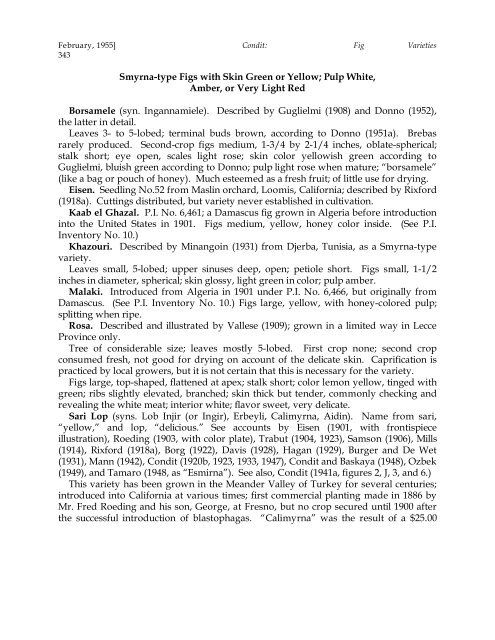Fig Varieties: A Monograph - uri=ucce.ucdavis
Fig Varieties: A Monograph - uri=ucce.ucdavis
Fig Varieties: A Monograph - uri=ucce.ucdavis
Create successful ePaper yourself
Turn your PDF publications into a flip-book with our unique Google optimized e-Paper software.
February, 1955] Condit: <strong>Fig</strong> <strong>Varieties</strong><br />
343<br />
Smyrna-type <strong>Fig</strong>s with Skin Green or Yellow; Pulp White,<br />
Amber, or Very Light Red<br />
Borsamele (syn. Ingannamiele). Described by Guglielmi (1908) and Donno (1952),<br />
the latter in detail.<br />
Leaves 3- to 5-lobed; terminal buds brown, according to Donno (1951a). Brebas<br />
rarely produced. Second-crop figs medium, 1-3/4 by 2-1/4 inches, oblate-spherical;<br />
stalk short; eye open, scales light rose; skin color yellowish green according to<br />
Guglielmi, bluish green according to Donno; pulp light rose when mature; “borsamele”<br />
(like a bag or pouch of honey). Much esteemed as a fresh fruit; of little use for drying.<br />
Eisen. Seedling No.52 from Maslin orchard, Loomis, California; described by Rixford<br />
(1918a). Cuttings distributed, but variety never established in cultivation.<br />
Kaab el Ghazal. P.I. No. 6,461; a Damascus fig grown in Algeria before introduction<br />
into the United States in 1901. <strong>Fig</strong>s medium, yellow, honey color inside. (See P.I.<br />
Inventory No. 10.)<br />
Khazouri. Described by Minangoin (1931) from Djerba, Tunisia, as a Smyrna-type<br />
variety.<br />
Leaves small, 5-lobed; upper sinuses deep, open; petiole short. <strong>Fig</strong>s small, 1-1/2<br />
inches in diameter, spherical; skin glossy, light green in color; pulp amber.<br />
Malaki. Introduced from Algeria in 1901 under P.I. No. 6,466, but originally from<br />
Damascus. (See P.I. Inventory No. 10.) <strong>Fig</strong>s large, yellow, with honey-colored pulp;<br />
splitting when ripe.<br />
Rosa. Described and illustrated by Vallese (1909); grown in a limited way in Lecce<br />
Province only.<br />
Tree of considerable size; leaves mostly 5-lobed. First crop none; second crop<br />
consumed fresh, not good for drying on account of the delicate skin. Caprification is<br />
practiced by local growers, but it is not certain that this is necessary for the variety.<br />
<strong>Fig</strong>s large, top-shaped, flattened at apex; stalk short; color lemon yellow, tinged with<br />
green; ribs slightly elevated, branched; skin thick but tender, commonly checking and<br />
revealing the white meat; interior white; flavor sweet, very delicate.<br />
Sari Lop (syns. Lob Injir (or Ingir), Erbeyli, Calimyrna, Aidin). Name from sari,<br />
“yellow,” and lop, “delicious.” See accounts by Eisen (1901, with frontispiece<br />
illustration), Roeding (1903, with color plate), Trabut (1904, 1923), Samson (1906), Mills<br />
(1914), Rixford (1918a), Borg (1922), Davis (1928), Hagan (1929), Burger and De Wet<br />
(1931), Mann (1942), Condit (1920b, 1923, 1933, 1947), Condit and Baskaya (1948), Ozbek<br />
(1949), and Tamaro (1948, as “Esmirna”). See also, Condit (1941a, figures 2, J, 3, and 6.)<br />
This variety has been grown in the Meander Valley of Turkey for several centuries;<br />
introduced into California at various times; first commercial planting made in 1886 by<br />
Mr. Fred Roeding and his son, George, at Fresno, but no crop secured until 1900 after<br />
the successful introduction of blastophagas. “Calimyrna” was the result of a $25.00
















![Fig Trees in North Carolina [Archive] - IDigMyGarden ... - Figs 4 Fun](https://img.yumpu.com/26905320/1/190x245/fig-trees-in-north-carolina-archive-idigmygarden-figs-4-fun.jpg?quality=85)